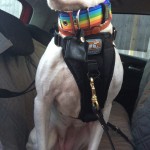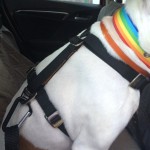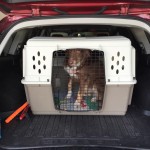With winter coming upon us, it is more important than ever to encourage your clients to evaluate how their dogs ride in the car. Many of our clients are perfectly content to allow their pooch to roam freely around the car, or even sit in the driver’s lap or on the windshield while the car is in motion. Though some think this is harmless and makes for cute pictures, all it takes is a split second for the client and their dog’s lives to get impacted forever.
Car safety cannot be emphasized enough with clients. As modern dog trainers, it is up to you to emphasize safety in all aspects of dog’s lives, not just immediate training needs. As somebody who has spun off the road with my dog in the car (fortunately we were both buckled in so did not get injured), car safety is a high priority. So what are options for car safety, and what behaviors does a dog need to know?
Car Harnesses
Harness are probably the easiest, most cost-efficient and space-saving option for most dog owners. A good harness will be wide across the chest and fully cover the chest down to the girth, but without hindering the neck or shoulders. It will have some padding and solid metal hardware. There are generally two main attachment points for car harnesses – either a metal hook that attaches to a sturdy strap and carabiner (as pictured below), or a loop that the car’s seatbelt will go through before being latched. Either way, the dog should be able to sit, stand, or lie down, but not be able to roam around. If they can move too far, that means they will not be as secure in case of an accident. Look for harnesses that have actual safety ratings. The harness in these pictures is Kurgo’s Tru-Fit Enhanced Strength Harness.
What behaviors should the dog know?
- The dog should be happy about wearing a harness, especially one that has a little more coverage than most walking-type harnesses.
- The dog should be able to sit quietly in one place without panicking. If the dog is spinning around, they can get tangled in the harness and injure themselves while also distracting the driver.
- The dog should wait to be invited into the car, and also should wait to be invited OUT of the car.
Crates
A solid, well-secured crate will be safer than a car harness as it will not only keep the dog from being flung around the car, but it will keep other flying items from impacting the dog. The best of the best when it comes to car-specific crates is the Mim Variocage. However, as these are rather pricey, they are out of limits for most people. The next best is a variokennel or wire crate that is, again, properly secured to the car. A crate will be no use if it can go bouncing around the car because it is not secured. You want to make sure it’s just big enough for the dog to fit comfortably, but not spacious enough for them to be able to sprawl out and have oodles of room. Again, the goal is car safety and keeping them secure in case of an accident.
What behaviors should the dog know?
- The dog needs to be crate-trained so they do not panic when placed in the crate.
- The dog should know how to chew appropriately provided toys/bones instead of fussing with the straps securing the crate to the vehicle.
- The dog should wait to be invited into the car, and also should wait to be invited OUT of the car.
What NOT To Do
- Allow the dog to hang his/her head out the window – Even at slow speeds, debris is kicked off the road by other vehicles and may severely injure the dog.
- Allow the dog to ride on the driver’s lap – A dog in the driver’s lap is incredibly distracting for the driver. And if there is a car accident, there is a high likelihood the airbag impact will kill the dog.
- Allow the dog to ride on the dashboard – In the case of an accident, a dog riding on the dashboard has very little chance of escaping unscathed. Also, they will hinder visibility and act as a distraction for the driver.
- Use a collar and leash to secure dog to headrest or other part of car – in case of an accident, all that pressure suddenly pulling on the dog’s collar will cause SERIOUS injury.
- Fail to have identification on dog – If there is an accident, and your dog manages to get loose, it is imperative that they have a collar with tags on so they can be quickly reunited. Microchips are wonderful, too, but only as backup to a collar and tags.
What tips do you have for car safety for dogs?
Dog Training Business Tips
Receive valuable dog training business tips and resources right in your inbox! Subscribe to The Modern Dog Trainer now by submitting your name and email below. Don’t forget to let us know what you want to learn more about!
[mc4wp_form]







